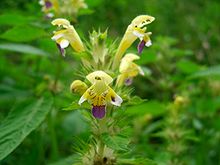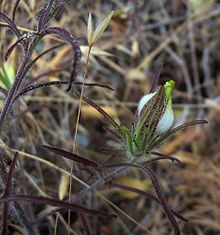Lamiales
| Lamiales Temporal range:
| |
|---|---|

| |
| Galeopsis speciosa | |
| Scientific classification | |
| Kingdom: | Plantae |
| Clade: | Tracheophytes |
| Clade: | Angiosperms |
| Clade: | Eudicots |
| Clade: | Asterids |
| Clade: | Lamiids |
| Order: | Lamiales Bromhead[2] |
| Families[3] | |
| |
This article includes a list of generalreferences,butit lacks sufficient correspondinginline citations.(May 2012) |
TheorderLamiales(also known as themint order) are an order in theasteridgroup ofdicotyledonousflowering plants.[4][5]It includes about 23,810species,1,059 genera, and is divided into about 25families.[4]These families includeAcanthaceae,Bignoniaceae,Byblidaceae,Calceolariaceae,Carlemanniaceae,Gesneriaceae,Lamiaceae,Lentibulariaceae,Linderniaceae,Martyniaceae,Mazaceae,Oleaceae,Orobanchaceae,Paulowniaceae,Pedaliaceae,Peltantheraceae,Phrymaceae,Plantaginaceae,Plocospermataceae,Schlegeliaceae,Scrophulariaceae,Stilbaceae,Tetrachondraceae,Thomandersiaceae,Verbenaceae.[4]
Being one of the largest orders of flowering plants, Lamiales have representatives found all over the world. Well-known or economically important members of this order includelavender,lilac,olive,jasmine,theash tree,teak,snapdragon,sesame,psyllium,garden sage,and a number of table herbs such asmint,basil,androsemary.[6]
Description
[edit]
Plant species within the order Lamiales areeudicotsand are herbaceous or have woody stems.[5]Zygomorphicflowers are common in Lamiales, having five petals with an upper lip of two petals and lower lip of three petals, howeveractinomorphicflowers are also seen.[5][7]Plant species within the order Lamiales potentially have fivestamens,but these are typically reduced to two or four.[5][7]Lamiales also produce a singlestyleattached to an ovary typically containing twocarpels.[8]Theovaryin the Lamiales order is mostly observed to besuperior.[9]Lamialesinflorescenceis typically seen ascyme,racemeorspike.[6]Fruittype in Lamiales order is usuallydehiscentcapsules.[10]Glandular hairsare present in Lamiales.[5]
Habitat
[edit]The Lamiales order can be found in almost all kinds of habitats world-wide.[11]These habitats includeforests,valleys,grasslands,rocky terrain,rainforests,the tropics,temperate regions,marshes,coastlines,and even frozen areas.[9][11][12]
Carnivore plants
[edit]
A number of species ofcarnivorous plantsare found in the Lamiales, in the familiesLentibulariaceaeandByblidaceae.[6]Protocarnivorousplant species have also been found in the order Lamiales, specifically in the familiesMartyniaceae.[6]
Parasitic plants
[edit]
Parasitic plantspecies are found in the order Lamiales, belonging to the familyOrobanchaceae.[6]These parasitic plants can either behemi-parasitesorholoparasites.[6]
Uses
[edit]The order Lamiales has a variety of species with anthropogenic uses, the most popular belonging to theLamiaceaeandAcanthaceaefamilies.[12]Many of these species in the order Lamiales produce medicinal properties fromalkaloidsandsaponinsto help a variety ofinfectionsanddiseases.[12]These alkaloids and saponins may help withdigestion,thecommon coldorflu,asthma,liver infections,pulmonary infectionsand containantioxidantproperties.[12]
Plant species within the order Lamiales are also known to have properties to repel insects and help control harmful diseases from insects, such asMalariafrommosquitos.[13][12]The plant familyAcanthaceaewithin the Lamiales order have bioactive secondary metabolites within their mature leaves, which have been found to be toxic to insect larvae.[13]Botanical derived insecticides are a good alternate for chemical or synthetic insecticides as it is inexpensive, abundant and safe for other plants, non-target organisms and the environment.[13]
Many species within the order Lamiales are also used as decorations,flavouring agents,cosmeticsandfragrances.[12]Natural dyescan also be extracted from plant species within Lamiales.[12][14]For example, inSardiniaculture, the most common Lamiales plant species used for natural dyes isLavandula stoechas,where a light-green dye is extracted from the stem.[14]
Taxonomy
[edit]The Lamiales previously had a restricted circumscription (e.g., byArthur Cronquist) that included the major familiesLamiaceae(Labiatae),Verbenaceae,andBoraginaceae,plus a few smaller families. In the classification system ofDahlgrenthe Lamiales were in thesuperorderLamiiflorae (also called Lamianae). Recent phylogenetic work has shown the Lamiales arepolyphyleticwith respect to orderScrophularialesand the two groups are now usually combined in a single order that also includes the former ordersHippuridalesandPlantaginales.Lamiales has become the preferred name for this much larger combined group. The placement of theBoraginaceaeis unclear, but phylogenetic work shows this family does not belong in Lamiales.[citation needed]
Also, the circumscription of familyScrophulariaceae,formerly aparaphyleticgroup defined primarily byplesiomorphiccharacters and from within which numerous other families of the Lamiales were derived, has been radically altered to create a number of smaller, better-defined, and putativelymonophyleticfamilies.[15]
Dating
[edit]Much research has been conducted in recent years regarding the dating the Lamialeslineage,although there still remains some ambiguity. A 2004 study, on the molecularphylogeneticdating ofasteridflowering plants, estimated 106 million years (MY) for the stem lineage of Lamiales.[16]A 2009 study onangiospermdiversification through time, concluded an inferred age of lowerEocene,ca. 50 MY, for Lamiales.[6]
References
[edit]- ^M. E. J. Chandler. 1964. The Lower Tertiary Floras of Southern England. IV. A summary and survey of findings in the light of recent botanical observations.
- ^Angiosperm Phylogeny Group (2009)."An update of the Angiosperm Phylogeny Group classification for the orders and families of flowering plants: APG III".Botanical Journal of the Linnean Society.161(2): 105–121.doi:10.1111/j.1095-8339.2009.00996.x.hdl:10654/18083.
- ^Angiosperm Phylogeny Group (2016)."An update of the Angiosperm Phylogeny Group classification for the orders and families of flowering plants: APG IV".Botanical Journal of the Linnean Society.181(1): 1–20.doi:10.1111/boj.12385.
- ^abcAllaby, Michael, ed. (2019).A Dictionary of Plant Sciences(4 ed.). Oxford University Press.doi:10.1093/acref/9780198833338.001.0001.ISBN978-0-19-883333-8.
- ^abcdeJ. W. Kadereit, ed. (2004).Flowering plants, dicotyledons: Lamiales (except Acanthaceae including Avicenniaceae).Berlin: Springer.ISBN3-540-40593-3.OCLC53375899.
- ^abcdefgSchäferhoff, Bastian; Fleischmann, Andreas; Fischer, Eberhard; Albach, Dirk C; Borsch, Thomas; Heubl, Günther; Müller, Kai F (2010)."Towards resolving Lamiales relationships: insights from rapidly evolving chloroplast sequences".BMC Evolutionary Biology.10(1): 352.doi:10.1186/1471-2148-10-352.ISSN1471-2148.PMC2992528.PMID21073690.
- ^abEndress, Peter K (February 2001). "Evolution of floral symmetry".Current Opinion in Plant Biology.4(1): 86–91.doi:10.1016/S1369-5266(00)00140-0.PMID11163173.
- ^Westerkamp, Christian; Claßen-Bockhoff, Regine (2007-08-01)."Bilabiate Flowers: The Ultimate Response to Bees?".Annals of Botany.100(2): 361–374.doi:10.1093/aob/mcm123.ISSN1095-8290.PMC2735325.PMID17652341.
- ^abZhang, Caifei; Zhang, Taikui; Luebert, Federico; Xiang, Yezi; Huang, Chien-Hsun; Hu, Yi; Rees, Mathew; Frohlich, Michael W; Qi, Ji; Weigend, Maximilian; Ma, Hong (2020-11-01). Saitou, Naruya (ed.)."Asterid Phylogenomics/Phylotranscriptomics Uncover Morphological Evolutionary Histories and Support Phylogenetic Placement for Numerous Whole-Genome Duplications".Molecular Biology and Evolution.37(11): 3188–3210.doi:10.1093/molbev/msaa160.ISSN0737-4038.PMID32652014.
- ^McDade, L. A.; Daniel, T. F.; Kiel, C. A. (2008-09-01). "Toward a comprehensive understanding of phylogenetic relationships among lineages of Acanthaceae s.l. (Lamiales)".American Journal of Botany.95(9): 1136–1152.doi:10.3732/ajb.0800096.ISSN0002-9122.PMID21632432.
- ^abFonseca, Luiz Henrique M. (November 2021). "Combining molecular and geographical data to infer the phylogeny of Lamiales and its dispersal patterns in and out of the tropics".Molecular Phylogenetics and Evolution.164:107287.doi:10.1016/j.ympev.2021.107287.PMID34365014.
- ^abcdefgSharma, Archna; Sharma, Alka; Kumar, Vijay; Kumar, Ashwini (2015)."Selected Medicinal Plants of Order Lamiales Used in Traditional Medicine".American Journal of Pharmacy and Health Research.3(1) – via ResearchGate.
- ^abcRawani, Anjali; Ghosh, Anupam; Chandra, Goutam (July 2014)."Mosquito larvicidal potential of four common medicinal plants of India".The Indian Journal of Medical Research.140(1): 102–108.ISSN0975-9174.PMC4181141.PMID25222784.
- ^abMaxia, Andrea; Meli, Francesca; Gaviano, Carla; Picciau, Rosangela; De Martis, Bruno; Kasture, Sanjay; Kasture, Veene (2013)."Dye plants: Natural resources from traditional botanical knowledge of Sardinia Island, Italy".Indian Journal of Traditional Knowledge:651–656.
- ^Schäferhoff, Bastian; Fleischmann, Andreas; Fischer, Eberhard; Albach, Dirk C; Borsch, Thomas; Heubl, Günther; Müller, Kai F (2010)."Towards resolving Lamiales relationships: insights from rapidly evolving chloroplast sequences".BMC Evolutionary Biology.10(1): 352.doi:10.1186/1471-2148-10-352.ISSN1471-2148.PMC2992528.PMID21073690.
- ^Bremer, K.; Friis, E. M.; Bremer, B. (2004)."Molecular phylogenetic dating of asterid flowering plants shows early Cretaceous diversification".Systematic Biology.53(3): 496–505.doi:10.1080/10635150490445913.ISSN1063-5157.PMID15503676.
External links
[edit]- Lamiales
- A parsimony analysis of the Asteridae sensu lato based on rbcL sequences
- Disintegration of the ScrophulariaceaeArchived2007-03-10 at theWayback Machine(deals with relationships throughout Lamiales)
- L. Watson and M.J. Dallwitz (1992 onwards). The families of flowering plants: descriptions, illustrations, identification, information retrieval.http://delta-intkey.com
- https://web.archive.org/web/20070609093942/http://www.biologie.uni-hamburg.de/b-online/vascular/acanth.htm2002-09-06
- https://web.archive.org/web/20070630151231/http://www.biologie.uni-hamburg.de/b-online/d52/52e.htm2002-09-06
- https://web.archive.org/web/20070609093206/http://www.biologie.uni-hamburg.de/b-online/d52/52efam.htm2002-09-06
- https://web.archive.org/web/20050914001131/http://www.science.siu.edu/parasitic-plants/Relation-Scroph.html
- https://web.archive.org/web/20070311032641/http://www.rbgkew.org.uk/web.dbs/genlist.html2002-09-06
 Media related toLamialesat Wikimedia Commons
Media related toLamialesat Wikimedia Commons Data related toLamialesat Wikispecies
Data related toLamialesat Wikispecies

